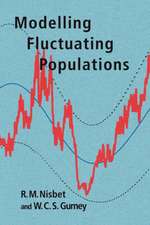Insect Life Cycles: Genetics, Evolution and Co-ordination
Editat de Francis Gilberten Limba Engleză Paperback – 11 dec 2012
Preț: 999.94 lei
Preț vechi: 1219.43 lei
-18% Nou
Puncte Express: 1500
Preț estimativ în valută:
191.34€ • 200.28$ • 159.25£
191.34€ • 200.28$ • 159.25£
Carte tipărită la comandă
Livrare economică 31 martie-14 aprilie
Preluare comenzi: 021 569.72.76
Specificații
ISBN-13: 9781447134664
ISBN-10: 1447134664
Pagini: 276
Ilustrații: XIV, 258 p. 107 illus.
Dimensiuni: 170 x 244 x 14 mm
Greutate: 0.45 kg
Ediția:Softcover reprint of the original 1st ed. 1990
Editura: SPRINGER LONDON
Colecția Springer
Locul publicării:London, United Kingdom
ISBN-10: 1447134664
Pagini: 276
Ilustrații: XIV, 258 p. 107 illus.
Dimensiuni: 170 x 244 x 14 mm
Greutate: 0.45 kg
Ediția:Softcover reprint of the original 1st ed. 1990
Editura: SPRINGER LONDON
Colecția Springer
Locul publicării:London, United Kingdom
Public țintă
ResearchDescriere
No International Congress of Entomology would now be complete without a symposium on insect life-cycles. The latest Congress, held at Vancouver, BC (Canada), in July 1988, was no exception, with a symposium on the genetics, evolution, and coordination of insect life cycles organized by Bill Bradshaw and Valerie Brown. The present volume arose from papers contributed by most of the speakers at the symposium, together with papers from other invited authors. In editing the book, I have been assisted greatly by the other authors, particularly Bill Bradshaw, Val Brown and Fritz Taylor. All contributors agreed to referee two other chapters, a system that worked efficiently and effectively: I thank all authors for performing this task in the face of other demands on their time. I would also like to thank Philip Corbet, John Greenslade, Bryan Clarke, and Gillian Thompson of Springer for their help. Nottingham Francis Gilbert January 1990 Contents List of Contributors ....................................................... xiii SECTION I. Genetics of Life-Cycle Traits Introduction William E. Bradshaw ................................................. 3 1 Understanding the Evolution of Insect Life-Cycles: The Role of Genetic Analysis.
Cuprins
Section I. Genetics of Life-Cycle Traits.- 1 Understanding the Evolution of Insect Life-Cycles: The Role of Genetic Analysis.- 1.1 Introduction.- 1.2 Are the Predictions of the Two Approaches the Same?.- 1.3 Can Optimality Models Maintain Variation?.- 1.4 Does Phenotypic Variation Reflect Genetic Variation?.- 1.5 What Maintains Genetic Variation?.- 1.5.1 Environmental Heterogeneity.- 1.5.2 Antagonistic Pleiotropy.- 1.6 Concluding Comments.- 1.7 Summary.- 2 The Use of Selection to Probe Patterns of Pleiotropy in Fitness Characters.- 2.1 Introduction.- 2.2 Laboratory Natural Selection.- 2.2.1 Selection Procedures.- 2.2.2 Response to Laboratory Natural Selection for Later Reproduction.- 2.2.3 Response to Reversal of Laboratory Natural Selection.- 2.3 Artificial Truncation Selection.- 2.3.1 Selection Procedures.- 2.3.2 Direct Response to Artificial Selection.- 2.3.3 Indirect Response to Artificial Selection.- 2.4 Laboratory Culling.- 2.4.1 Selection Procedures.- 2.4.2 Response to Laboratory Culling.- 2.5 Comparison of the Selection Procedures.- 2.6 Patterns of Pleiotropy in Drosophila melanogaster Fitness Characters.- 2.6.1 What We Think We Know.- 2.6.2 What We Would Like to Know.- 2.7 Conclusions.- Section II. Evolution of Life-Cycle Traits.- 3 Evolution of Phenology and Demography in the Pitcher-Plant Mosquito, Wyeomyia smithii.- 3.1 Introduction.- 3.2 Life-Cycle of Wyeomyia smithii.- 3.3 Life-Cycle Traits and Geography.- 3.3.1 Predictions.- 3.3.2 Observed Phenological Traits.- 3.3.3 Observed Demographic Traits.- 3.4 Conclusions.- 4 Developmental Programmes and Adaptive Syndromes in Insect Life-Cycles.- 4.1 Introduction.- 4.2 Melanoplus sanguinipes.- 4.3 Gerris remigis.- 4.4 Oncopeltus fasciatus.- 4.5 Discussion.- 5 Coevolution Between Herbivorous Insects and Plants: Tempo and Orchestration.- 6 Size, Phylogeny, and Life-History in the Evolution of Feeding Specialization in Insect Predators.- 6.1 Introduction.- 6.2 Predictions.- 6.3 The Hoverflies (Diptera, Syrphidae).- 6.3.1 Species Considered.- 6.3.2 Data Used.- 6.4 Testing the Predictions.- 6.5 Discussion.- 7 Opportunistic Diapause in the Subtropical Ground Cricket, Dianemobius fascipes.- 7.1 Introduction.- 7.2 Ambiguity of the Subtropical Environment.- 7.3 The Subtropical Ground Cricket.- 7.4 Response to Temperature Rise.- 7.5 Response to Temperature Pulse.- 7.6 Stage Sensitive to High Temperature.- 7.7 Interacting Effect of Photoperiod and Temperature.- 7.8 Discussion.- 7.9 Summary.- 8 Evolution of Mutualistic Life-Cycles: Yucca Moths and Fig Wasps.- 8.1 Introduction.- 8.2 Natural History.- 8.3 Increasing the Probability of Association Between Host and Symbiont.- 8.3.1 Yuccas and Yucca Moths.- 8.3.2 Figs and Fig Wasps.- 8.4 Disruption of Mutualistic Life-Cycles.- 8.4.1 Figs and Fig Wasps.- 8.4.2 Yuccas and Yucca Moths.- 8.5 Conclusions.- 9 Testing Hypotheses About the Evolution of the Mean Phenotype in Temporally Variable Environments Fritz Taylor.- 9.1 Introduction.- 9.2 The Model.- 9.3 Results.- 9.3.1 Generation of Autocorrelation by Selection.- 9.3.2 Convergence of the Long-Term Phenotypic Mean.- 9.3.3 Convergence of the Standard Deviation of the Mean Phenotype.- 9.3.4 Convergence of the Long-Term Mean Phenotype.- 9.4 Discussion.- 9.5 Summary.- Section III. Coordination of Life-Cycle Traits.- 10 Insect Herbivores, Herbivory and Plant Succession Valerie K. Brown.- 10.1 Introduction.- 10.2 Insect Communities.- 10.2.1 Life-Cycle Strategies.- 10.3 Impact of Insect Herbivores.- 10.3.1 Community Effects.- 10.3.2 Comparative Studies.- 10.3.3 Effects of Insect Herbivores on Single Plant Species.- 10.4 Conclusions.- 11 Migration and the Coordination of Life-Cycles as Exemplified by Lygaeinae Bugs.- 11.1 Migration and Life-Histories.- 11.2 Three Steps in the Expression of Insect Migration by Flight.- 11.3 Within-Species Variation - Horvathiolus gibbicollis.- 11.4 Between-Species Comparisons.- 11.5 Conclusions.- 11.6 Summary.- 12 Competition and Selection in a Patchy and Ephemeral Habitat: The Implications for Insect Life-Cycles.- 12.1 Introduction.- 12.2 Competition.- 12.3 Selection.- 12.4 Implications.- 13 Facultative and Obligatory Diapause Responses in Three Species of Burnet Moth: A Characterization of Life-Cycle Phenologies by Field Observations and Laboratory Experiments.- 13.1 Introduction.- 13.2 Geographical Distribution of the Burnet Moth.- 13.3 Partivoltinism in the Burnet Moth.- 13.4 A Case of a Bivoltine Population?.- 13.5 Conclusions.- 13.5.1 Adaptive Significance of Repeated Diapauses in Northern Populations.- 13.5.2 Phenology, Synchrony and Voltinism at Southern Study Sites.- 14 The Present and Future of Insect Life-Cycle Evolution.- 14.1 Introduction.- 14.2 Maintenance of Genetic Variability for Fitness Traits.- 14.3 The Genetic Connection in Life-History Syndromes.- 14.4 Emergent Life-Cycle Patterns.- 14.5 Where Do We Go From Here?.- Species Index.
















